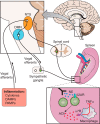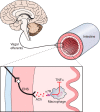Neuroimmune Communication in Health and Disease
- PMID: 30109819
- PMCID: PMC6170975
- DOI: 10.1152/physrev.00035.2017
Neuroimmune Communication in Health and Disease
Abstract
The immune and nervous systems are tightly integrated, with each system capable of influencing the other to respond to infectious or inflammatory perturbations of homeostasis. Recent studies demonstrating the ability of neural stimulation to significantly reduce the severity of immunopathology and consequently reduce mortality have led to a resurgence in the field of neuroimmunology. Highlighting the tight integration of the nervous and immune systems, afferent neurons can be activated by a diverse range of substances from bacterial-derived products to cytokines released by host cells. While activation of vagal afferents by these substances dominates the literature, additional sensory neurons are responsive as well. It is becoming increasingly clear that although the cholinergic anti-inflammatory pathway has become the predominant model, a multitude of functional circuits exist through which neuronal messengers can influence immunological outcomes. These include pathways whereby efferent signaling occurs independent of the vagus nerve through sympathetic neurons. To receive input from the nervous system, immune cells including B and T cells, macrophages, and professional antigen presenting cells express specific neurotransmitter receptors that affect immune cell function. Specialized immune cell populations not only express neurotransmitter receptors, but express the enzymatic machinery required to produce neurotransmitters, such as acetylcholine, allowing them to act as signaling intermediaries. Although elegant experiments have begun to decipher some of these interactions, integration of these molecules, cells, and anatomy into defined neuroimmune circuits in health and disease is in its infancy. This review describes these circuits and highlights continued challenges and opportunities for the field.
Figures




References
-
- Andresen MC, Yang MY. Non-NMDA receptors mediate sensory afferent synaptic transmission in medial nucleus tractus solitarius. Am J Physiol Heart Circ Physiol 259: H1307–H1311, 1990. - PubMed
Publication types
MeSH terms
Grants and funding
LinkOut - more resources
Full Text Sources
Other Literature Sources
Medical

